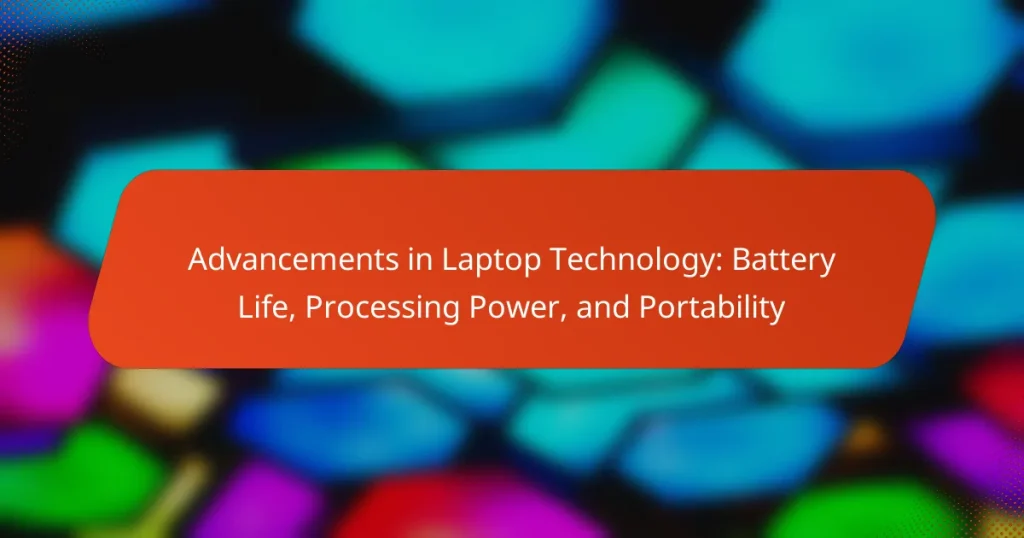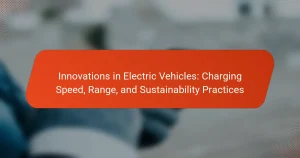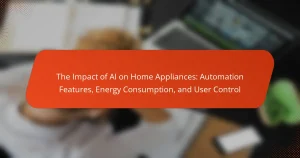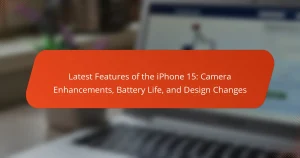Recent advancements in laptop technology focus on three primary areas: battery life, processing power, and portability. Improved battery life enables laptops to operate for up to 20 hours on a single charge, enhancing productivity for users who require extended usage without frequent recharging. The latest multi-core processors, such as Intel’s 13th generation, offer superior performance while consuming less energy, facilitating faster application loading and multitasking capabilities. Furthermore, advancements in lightweight materials and ultra-slim designs have made modern laptops more portable, meeting the demands of mobile users who prioritize convenience and versatility in their computing devices.

What are the Recent Advancements in Laptop Technology?
Recent advancements in laptop technology include improved battery life, enhanced processing power, and greater portability. Battery life has increased significantly, with some models now offering up to 20 hours of usage on a single charge. This is achieved through more efficient battery technologies and power management systems. Processing power has also seen advancements, with the latest laptops featuring multi-core processors that can handle demanding applications seamlessly. For instance, Intel’s 13th generation processors provide better performance while consuming less energy. Additionally, portability has improved with the introduction of lighter materials and thinner designs. Many laptops now weigh under 3 pounds, making them easier to carry. These advancements reflect ongoing trends in consumer demand for longer-lasting, faster, and more mobile computing devices.
How have battery life improvements changed user experiences?
Battery life improvements have significantly enhanced user experiences by reducing the frequency of recharging. Longer battery life allows users to work, play, and communicate without interruption. Users can now rely on their devices for extended periods, increasing productivity and convenience. For example, many laptops now offer 10 to 20 hours of battery life, compared to just a few hours in earlier models. This advancement enables professionals to complete tasks during travel or in locations without power access. Additionally, improved battery efficiency contributes to lighter and thinner designs, enhancing portability. Users benefit from a seamless experience, as devices can maintain performance without the anxiety of running out of power.
What technologies contribute to enhanced battery life?
Lithium-ion battery technology significantly contributes to enhanced battery life. This technology offers higher energy density compared to previous battery types. It allows devices to hold more charge without increasing size. Fast charging capabilities reduce downtime, enhancing user experience. Battery management systems optimize power usage and prolong lifespan. Energy-efficient processors also play a critical role in reducing power consumption. These processors adapt performance based on workload, minimizing unnecessary energy use. Lastly, software optimizations can further improve battery longevity by managing background processes effectively.
How does battery capacity impact overall laptop performance?
Battery capacity directly impacts overall laptop performance by determining how long the device can operate without charging. A higher battery capacity allows for extended usage time, enabling users to perform tasks longer without interruptions. This is particularly important for resource-intensive applications, as they require more power. When the battery is low, laptops often reduce performance to conserve energy. This can lead to slower processing speeds and reduced functionality. For example, laptops with a 5000 mAh battery can typically last longer under heavy usage compared to those with a 3000 mAh battery. Therefore, battery capacity is a critical factor in maintaining optimal laptop performance during use.
What innovations have been made in processing power?
Recent innovations in processing power include the development of multi-core processors. Multi-core technology allows multiple processing units to work simultaneously. This significantly enhances performance for multitasking and complex computations.
Another innovation is the introduction of smaller process nodes, such as 7nm and 5nm technologies. These smaller nodes increase transistor density, leading to improved efficiency and speed. For example, the Apple M1 chip utilizes a 5nm process, delivering high performance with lower power consumption.
Artificial intelligence (AI) integration into processors has also advanced processing capabilities. AI accelerators enable faster data processing for machine learning tasks. This innovation is evident in NVIDIA’s A100 Tensor Core GPU, designed specifically for AI workloads.
Additionally, advancements in heterogeneous computing allow different types of processors to work together. This includes combining CPUs with GPUs for enhanced performance in graphics and parallel processing tasks.
These innovations collectively contribute to the significant improvements seen in laptop processing power, enhancing overall user experience.
How do different processors compare in performance?
Different processors vary significantly in performance based on architecture, core count, and clock speed. For example, Intel’s Core i9 processors typically outperform Core i5 models due to higher core counts and faster clock speeds. AMD’s Ryzen 9 series also competes closely with Intel’s top offerings, often excelling in multi-threaded tasks. Benchmarks from sources like PassMark show that processors with more cores handle parallel tasks better. Additionally, thermal design power (TDP) influences sustained performance under load. Overall, the performance comparison depends on specific use cases, such as gaming versus productivity tasks.
What role does multi-core technology play in modern laptops?
Multi-core technology enhances processing power in modern laptops. It allows multiple tasks to be executed simultaneously. This capability improves performance for demanding applications. Multi-core processors can handle multitasking more efficiently. They distribute workloads across cores, reducing bottlenecks. This leads to faster execution of software and applications. For instance, video editing and gaming benefit significantly from multi-core technology. According to Intel, multi-core processors can improve performance by up to 70% in multi-threaded applications. Thus, multi-core technology is essential for modern laptop efficiency and user experience.
How has portability evolved in laptop design?
Portability in laptop design has evolved significantly over the years. Early laptops weighed over 10 pounds and were bulky. Modern laptops often weigh around 2 to 4 pounds, making them much easier to carry. Battery technology has improved, allowing for longer usage without needing a power source. Additionally, advancements in materials have led to thinner and lighter designs. The introduction of solid-state drives (SSDs) has also reduced weight compared to traditional hard drives. Furthermore, manufacturers have focused on creating compact, foldable designs that enhance portability. These changes have made laptops more convenient for mobile users.
What materials are being used to enhance portability?
Lightweight alloys such as aluminum and magnesium are commonly used to enhance portability in laptops. These materials provide strength while significantly reducing weight. Carbon fiber is also utilized for its high strength-to-weight ratio. Additionally, plastics like polycarbonate are favored for their lightweight properties. These materials contribute to thinner designs and easier transportability. Research indicates that using these materials can reduce the overall weight of laptops by up to 30%. This weight reduction directly improves user convenience and mobility.
How does screen size affect the portability of laptops?
Screen size significantly affects the portability of laptops. Smaller screens, typically ranging from 11 to 14 inches, contribute to lightweight designs. Laptops with larger screens, such as 15 inches and above, tend to be heavier and bulkier. This increased weight makes them less convenient for travel. Additionally, smaller laptops often have more compact dimensions, fitting easily into bags. In contrast, larger laptops require more space, which can be cumbersome. Portability is crucial for users who frequently move between locations. According to a study by TechRadar, laptops under 3 pounds are preferred for portability. Thus, screen size directly influences how easily a laptop can be transported.
What are the implications of these advancements for consumers?
Advancements in laptop technology significantly enhance consumer experiences. Improved battery life allows users to work longer without recharging. Enhanced processing power leads to faster performance for applications and multitasking. Increased portability makes laptops lighter and easier to carry, promoting on-the-go productivity. These improvements enable consumers to engage in more demanding tasks, such as gaming or video editing, without performance issues. Additionally, longer battery life contributes to convenience and reduces dependency on power outlets. Overall, these advancements lead to greater efficiency and satisfaction for consumers.
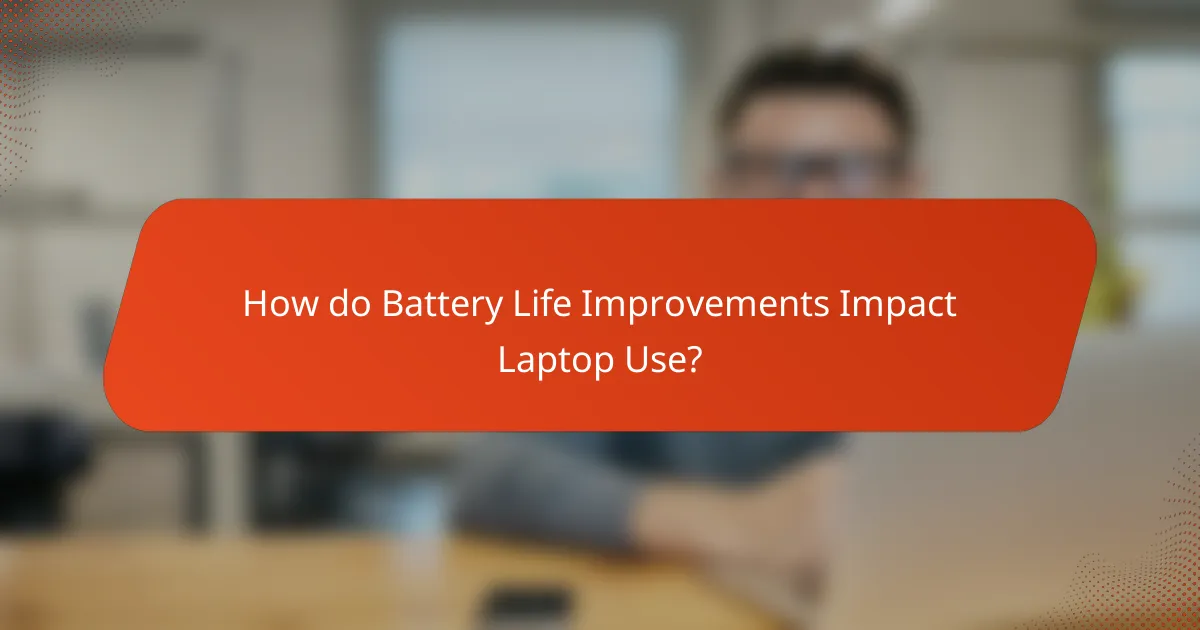
How do Battery Life Improvements Impact Laptop Use?
Battery life improvements significantly enhance laptop use. Longer battery life allows users to work without frequent interruptions for charging. This enables greater productivity, especially for professionals on the go. Improved battery performance also enhances portability, making laptops more convenient for travel. Users can enjoy extended usage during meetings, conferences, or while commuting. According to a study by the International Journal of Computer Applications, laptops with extended battery life can last up to 12 hours on a single charge. This advancement supports a more flexible work environment. Overall, better battery life directly correlates with increased user satisfaction and efficiency.
What are the typical battery life expectations for modern laptops?
Modern laptops typically have a battery life expectation ranging from 6 to 12 hours. This duration varies based on usage, hardware specifications, and battery capacity. For instance, ultrabooks often reach the higher end of this range due to energy-efficient components. In contrast, gaming laptops may only last 3 to 5 hours under heavy use. According to a 2021 study by Laptop Magazine, many mainstream laptops average around 8 to 10 hours of battery life during regular tasks. This indicates significant advancements in battery technology and energy management in recent years.
How can users maximize their laptop’s battery life?
Users can maximize their laptop’s battery life by adjusting power settings and managing usage habits. Reducing screen brightness can significantly decrease energy consumption. Closing unused applications and tabs also helps conserve battery power. Users should enable battery saver mode, which optimizes settings for efficiency. Disconnecting peripherals when not in use can further extend battery life. Keeping the laptop cool prevents overheating, which can degrade battery performance. Regularly updating software ensures optimal battery management features are utilized. Finally, maintaining battery health by avoiding deep discharges can prolong overall lifespan.
What are the trade-offs between battery life and performance?
Battery life and performance often have a direct trade-off relationship in laptops. Higher performance typically requires more power, which can drain the battery faster. For example, running demanding applications like video editing software increases CPU and GPU usage, leading to reduced battery longevity. Conversely, optimizing for battery life often involves throttling performance. This means reducing processor speed and limiting resource-intensive tasks. Many laptops feature power-saving modes to extend battery life by lowering performance. According to a study by the International Journal of Computer Applications, laptops can achieve up to 30% longer battery life when performance settings are adjusted. Balancing these factors is crucial for users who need both longevity and speed.
What charging technologies are influencing battery life?
Fast charging technologies significantly influence battery life. These technologies minimize charging time while preserving battery health. For instance, Qualcomm’s Quick Charge technology can charge devices up to 50% faster than standard methods. Similarly, USB Power Delivery enables higher wattage, allowing for quicker charging without overheating. Wireless charging innovations also affect battery longevity. They provide convenience but may generate more heat than wired options. Battery management systems optimize charging cycles, extending overall battery life. Adaptive charging adjusts the power based on usage patterns, further protecting battery health. Collectively, these technologies enhance user experience while maintaining battery performance.
How do fast charging and wireless charging differ?
Fast charging and wireless charging are two distinct methods of powering devices. Fast charging delivers higher power levels through a direct wired connection. This method reduces charging time significantly, often fully charging a device in under an hour. Wireless charging, on the other hand, uses electromagnetic fields to transfer energy without physical connectors. This method is generally slower, taking longer to charge the device compared to fast charging. Fast charging typically uses a USB-C or proprietary cable, while wireless charging relies on a compatible charging pad. The efficiency of fast charging can reach up to 80% or more, whereas wireless charging efficiency usually ranges from 60% to 80%.
What advancements are being made in battery technology?
Advancements in battery technology focus on increasing energy density and reducing charging times. New lithium-sulfur batteries promise higher capacity than traditional lithium-ion batteries. Solid-state batteries are emerging, offering improved safety and longevity. Researchers are exploring graphene as a material to enhance conductivity and efficiency. Fast-charging technologies are being developed, enabling devices to charge significantly quicker. Companies are investing in recycling methods to improve sustainability in battery production. These advancements aim to extend battery life and enhance overall performance in laptops and other devices.

What Role Does Processing Power Play in Laptop Performance?
Processing power is crucial for laptop performance. It determines how quickly a laptop can execute tasks. Higher processing power allows for faster application loading and smoother multitasking. It influences the ability to run demanding software, such as video editing tools and gaming applications. For example, laptops with Intel Core i7 processors perform significantly better than those with Intel Core i3 processors in benchmarking tests. This performance difference is measurable in frame rates and rendering times. Additionally, processing power impacts battery efficiency. More efficient processors can perform tasks while consuming less power, extending battery life.
How do different types of processors affect laptop capabilities?
Different types of processors significantly impact laptop capabilities. Processors determine the speed and efficiency of tasks. For instance, Intel Core processors are known for their high performance in multitasking and gaming. AMD Ryzen processors offer strong performance in parallel processing and are often more cost-effective.
The number of cores in a processor influences how many tasks it can handle simultaneously. Quad-core processors can manage more applications at once compared to dual-core processors. Additionally, processor architecture affects power consumption and heat generation. More efficient processors can extend battery life, allowing for longer use without charging.
Clock speed, measured in GHz, indicates how fast a processor can execute instructions. Higher clock speeds typically result in better performance for demanding applications. Integrated graphics capabilities also vary among processors, affecting gaming and graphical tasks.
Overall, the choice of processor directly correlates with the laptop’s performance, battery life, and ability to handle specific tasks effectively.
What are the key specifications to consider when choosing a processor?
Key specifications to consider when choosing a processor include clock speed, core count, thermal design power (TDP), and architecture. Clock speed, measured in GHz, indicates how fast the processor can execute instructions. Higher clock speeds typically lead to better performance. Core count refers to the number of independent processing units within the processor. More cores allow for better multitasking and improved performance in parallel processing tasks. Thermal design power (TDP) measures the maximum heat generated by the processor under load. A lower TDP often means better energy efficiency. Architecture defines the design and instruction set of the processor. Newer architectures generally offer better performance and efficiency. These specifications are critical for ensuring optimal performance in laptops.
How does thermal management influence processing power?
Thermal management significantly influences processing power by regulating the temperature of computer components. When processors operate at high temperatures, they can throttle performance to prevent damage. This throttling reduces the clock speeds and overall processing capabilities. Effective thermal management systems, such as heat sinks and cooling fans, maintain optimal temperatures. For instance, Intel’s Turbo Boost technology adjusts performance based on thermal conditions. Research shows that maintaining a temperature below 85°C can optimize CPU performance. Therefore, efficient thermal management directly correlates to improved processing power and system stability.
What are the emerging trends in processing technology?
Emerging trends in processing technology include increased use of artificial intelligence and machine learning. These technologies enhance performance and efficiency in data processing tasks. Additionally, there is a shift towards heterogeneous computing. This involves utilizing multiple types of processors, such as CPUs and GPUs, to optimize tasks. Quantum computing is also gaining traction. It promises to revolutionize processing capabilities by solving complex problems faster than traditional computers. Furthermore, energy-efficient processors are becoming more prevalent. These processors reduce power consumption while maintaining high performance. The integration of 5G technology is another trend. It enables faster data transfer and improved connectivity for processing tasks. Lastly, advancements in chip architecture are notable. They allow for better performance scaling and energy efficiency in modern devices.
How is artificial intelligence impacting processing power?
Artificial intelligence is significantly enhancing processing power. AI algorithms require substantial computational resources. This demand drives advancements in hardware capabilities. Modern processors are being designed specifically for AI tasks. These processors include specialized units like TPUs and GPUs. They improve efficiency in handling large datasets. For instance, NVIDIA’s A100 Tensor Core GPU offers 54 billion transistors. This enables faster training of AI models. Consequently, the overall performance of laptops improves. Enhanced processing power facilitates more complex AI applications.
What future developments can we expect in laptop processors?
Future developments in laptop processors will focus on increased efficiency and performance. Innovations will include smaller manufacturing processes, such as 3nm and 2nm technologies. These advancements will allow for more transistors on a chip, enhancing processing power. Additionally, integrated AI capabilities will become standard, improving task management and energy efficiency.
The rise of heterogeneous computing will enable processors to better handle diverse workloads. This will lead to improved performance in graphics and machine learning tasks. Furthermore, advancements in thermal management will allow processors to operate at higher speeds without overheating.
According to industry reports, such as those from Gartner, these trends are expected to drive significant performance gains in the coming years. The focus on energy efficiency aligns with global sustainability goals, making future processors not only faster but also greener.
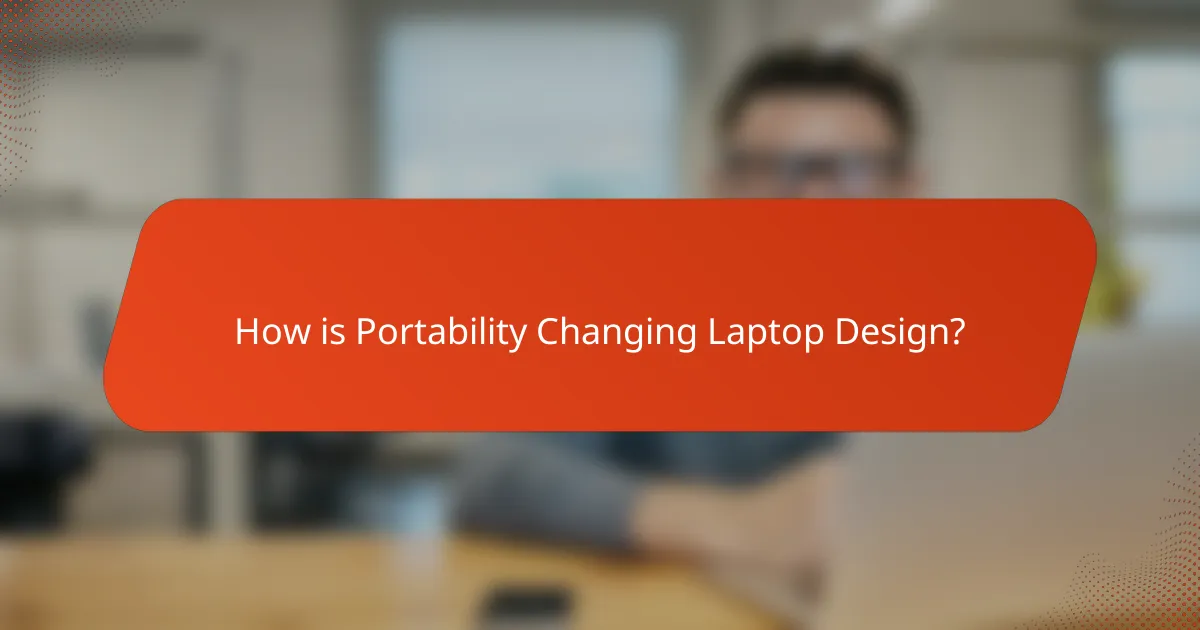
How is Portability Changing Laptop Design?
Portability is significantly influencing laptop design by prioritizing lightweight materials and compact dimensions. Manufacturers are increasingly using aluminum and carbon fiber to reduce weight without sacrificing durability. The trend towards thinner profiles has led to the development of ultra-slim laptops, often under 15mm in thickness. Additionally, advancements in battery technology allow for longer usage times in smaller form factors. The integration of efficient cooling systems has also become essential to maintain performance in compact designs. Features like detachable keyboards and 2-in-1 functionality are emerging to enhance versatility and portability. As a result, laptops are evolving to meet the demands of mobile users who require devices that are easy to carry and operate on the go.
What are the design trends for lightweight laptops?
Current design trends for lightweight laptops focus on minimalism, portability, and sustainability. Manufacturers prioritize slim profiles and lightweight materials like magnesium alloy and carbon fiber. The trend includes ultra-thin bezels that maximize screen space while maintaining a compact form. Many models feature 2-in-1 designs, allowing for versatility in usage. Enhanced keyboard designs improve typing comfort without adding weight. The integration of high-resolution displays is also common, providing better visual experiences in a lightweight format. Additionally, eco-friendly materials are increasingly used in construction, reflecting consumer demand for sustainable products. These trends align with consumer preferences for mobility and efficiency in modern computing.
How do foldable and detachable designs enhance portability?
Foldable and detachable designs enhance portability by allowing devices to be more compact and versatile. These designs enable users to easily adjust the form factor based on their needs. For example, a foldable laptop can transform into a tablet, reducing its size for transport. Detachable devices allow users to separate the keyboard from the screen, making it easier to carry the lighter component. This flexibility caters to various use cases, such as working in tight spaces or on the go. According to a study by IDC, devices with such designs are favored for their convenience, as they can fit into smaller bags. Overall, these innovations significantly improve user mobility and accessibility.
What impact do battery size and weight have on portability?
Battery size and weight significantly affect portability. Larger batteries typically increase the weight of laptops. Heavier laptops are more cumbersome to carry. This can deter users from taking them on the go. Conversely, smaller batteries reduce weight and enhance portability. Lightweight laptops are easier to transport and handle. Studies show that users prefer devices under 3 pounds for portability. A balance between battery life and weight is crucial for optimal user experience.
What are the best practices for choosing a portable laptop?
When choosing a portable laptop, prioritize weight, battery life, and performance. A laptop should weigh under 4 pounds for easy transport. Battery life should exceed 8 hours for all-day use. Look for models with at least an Intel i5 or AMD Ryzen 5 processor for sufficient power. Consider a minimum of 8GB RAM for smooth multitasking. Storage options should include SSD for faster load times. A 13 to 15-inch display offers a balance between usability and portability. Finally, read reviews to verify real-world performance and reliability.
What features should users prioritize for travel-friendly laptops?
Users should prioritize lightweight design, long battery life, and compact size for travel-friendly laptops. A lightweight design enhances portability, making it easier to carry during travel. Long battery life is crucial to ensure continuous use without frequent charging. A compact size allows for easy storage in bags and limited space on planes or trains. Additionally, durability is important to withstand the rigors of travel. Fast charging capabilities can also be beneficial for quick power-ups during layovers. These features collectively enhance the travel experience by providing convenience and reliability.
How does a laptop’s build quality affect its portability?
A laptop’s build quality significantly affects its portability. High-quality materials often result in lighter and thinner designs. Lighter laptops are easier to carry, enhancing portability. Durability also matters; robust builds withstand wear and tear during transport. For instance, laptops made of aluminum are generally lighter and more resilient than plastic counterparts. Additionally, a well-constructed hinge allows for smooth opening and closing, facilitating ease of use on the go. Therefore, build quality directly influences how easily a laptop can be transported and used in various environments.
What tips can enhance the overall laptop experience?
To enhance the overall laptop experience, users should optimize performance settings. Adjusting power settings can prolong battery life significantly. For instance, using ‘Battery Saver’ mode can extend usage by up to 30%. Regularly updating software ensures that the laptop runs efficiently. Keeping the operating system and applications up to date can improve security and performance. Additionally, maintaining proper ventilation prevents overheating. Overheating can lead to reduced performance and hardware damage. Using a laptop cooling pad can help maintain optimal temperatures. Finally, organizing files and regularly backing up data improves overall functionality and security. Efficient file management can enhance productivity and reduce time spent searching for documents.
The main entity of the article is advancements in laptop technology, specifically focusing on battery life, processing power, and portability. The article outlines recent improvements in battery technology that extend usage time, enhance processing capabilities through multi-core processors, and emphasize lightweight designs for increased portability. Key topics include the impact of battery life on user experience, innovations in processing power, and design trends that prioritize mobility. Additionally, the article discusses how these advancements collectively improve overall laptop performance and user satisfaction.
